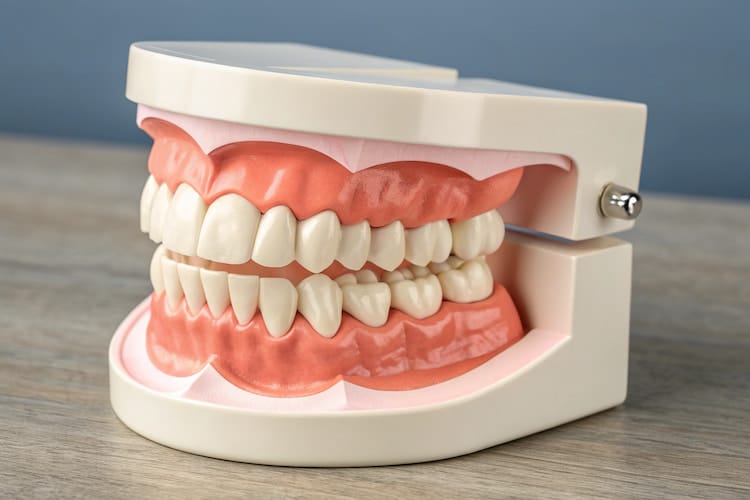When your teeth don’t meet the way they should, even simple things like chewing or smiling can feel uncomfortable. One of the most common bite problems orthodontists see is called a crossbite. Similar to other bite issues, like overbites, which can also affect jaw function and tooth health, ignoring a crossbite can lead to bigger concerns over time, such as uneven tooth wear, jaw pain, and even speech difficulties.
The good news is that crossbites can be corrected with dental braces, clear aligners, palate expanders, or, in severe cases, jaw surgery. Treatment can improve both the function and appearance of your bite, and your dentist will guide you on what to expect during each step of the process.
In this guide, we’ll walk you through what a crossbite is, why it happens, the risks of leaving it untreated, and the different treatment options you can expect.
Effective Treatments for Crossbite
A crossbite happens when your upper teeth fit inside your lower teeth, instead of slightly overlapping them as they normally should. Imagine closing a box lid that doesn’t fit properly, it tilts or slides to the side. That’s similar to how a crossbite affects your bite.

If you’re wondering, “How do you fix a crossbite?”, the answer is that it depends on your age and how severe the problem is. Dentists and orthodontists use different methods to move teeth or, in some cases, adjust the jaw itself. The goal is always the same: to make your bite healthy, comfortable, and long-lasting.
Here are the main options and what to expect with each:
Orthodontic Braces and Clear Aligners
Braces are one of the most common treatments for crossbite. They work by gently moving the teeth into their proper position. Clear aligners, like Invisalign, do the same job but are nearly invisible and removable.
With both options, you’ll need regular check-ups, and treatment usually lasts one to two years. Expect some mild pressure as your teeth shift, but this usually settles within a few days after each adjustment. And before starting, it’s a good idea to understand what to consider when choosing braces or aligners.
Palate Expanders
For children and teens, a palate expander is often the first step. It’s a small device placed in the roof of the mouth that slowly widens the upper jaw. Most kids get used to it quickly, though they might feel a little tightness at first. Once the jaw is expanded, braces or aligners may be used afterward to finish straightening the teeth. Parents can expect the whole process to take several months, but the results can prevent bigger problems later.
For more details on how palate expanders work and what to expect, you can read a helpful guide on the Cleveland Clinic.
Surgical Options
In adults with severe crossbite caused by jaw position, surgery may be the best solution. The procedure repositions the jaw so the teeth meet correctly. After healing, braces or aligners are often used to fine-tune the bite. While surgery sounds serious, it’s usually only recommended when other treatments wouldn’t work.

Types of Crossbite
Identifying the crossbite type is important because it influences the treatment approach, especially when deciding between braces, expanders, or surgery. They can vary depending on which teeth or jaw are affected. The main types include:
| Type | Description | Common Patients |
|---|---|---|
| Posterior | Upper back teeth bite inside lower back teeth | Children and teens |
| Anterior | Upper front teeth sit behind lower front teeth | Children, teens, adults |
| Mixed | A Combination of front and back teeth misalignment | Any age |
Common Causes of Crossbite
Several factors can lead to a crossbite. It’s usually a mix of genetics, childhood habits, and jaw development:
- Family history of bite or jaw issues
- Thumb-sucking or prolonged pacifier use
- Tongue thrusting
- Delayed loss of baby teeth
- Narrow upper jaw
- Mouth breathing caused by allergies or enlarged tonsils
Spotting these habits and jaw development issues early is important, which is why recognizing dental checkup importance plays a key role in maintaining healthy teeth and preventing problems like crossbites.
From Braces and Clear aligners to Surgical Consultations!
At Walk-in Family Dental, our experienced team provides personalized crossbite treatment for children, teens, and adults. Book your appointment today and take the first step toward a healthier, more comfortable smile.
Risks and Complications of Untreated Crossbite
If a crossbite is not treated, it can lead to several problems that affect your teeth, jaw, and overall oral health. Over time, these issues may become more serious and harder to correct. Common complications include:
- Uneven wear or chipping of teeth
- Jaw pain or discomfort, sometimes leading to TMJ problems
- Gum recession and increased sensitivity
- Difficulty chewing certain foods
- Speech challenges in more severe cases
- Lower confidence due to noticeable bite or smile issues
Treating a crossbite early can prevent most of these problems and help keep your teeth and jaw healthy.
What to Expect During Treatment
Treatment for a crossbite varies depending on the method used. Braces or clear aligners typically take 12–24 months, while palate expanders may only take a few months, and jaw surgery requires a recovery period of several weeks to months.
You may feel mild pressure or temporary soreness from braces, aligners, or expanders, which is normal as your teeth and jaw adjust.
Regular check-ups are important, usually every 4–6 weeks for braces or aligners, and more often for palate expanders. With proper care and follow-up, treatment can lead to improved bite function, reduced jaw discomfort, and a healthier smile.
What You Can Do Now to Correct Your Crossbite
A crossbite doesn’t have to affect your comfort, confidence, or oral health. The good news is that there are safe and effective treatments available for all ages, from braces and clear aligners to palate expanders and, in more severe cases, surgery. With the right guidance, you can improve bite function, reduce jaw discomfort, prevent long-term dental problems, and enjoy a smile you feel proud to show.
If you suspect you or your child has a crossbite, don’t wait. Book a consultation to take the first step toward a healthier, more confident smile. For those who need quick care, same-day appointments in North York are available to get you started as soon as possible.
FAQ
What is the best treatment for crossbite?
The best treatment depends on age and severity. Options include braces or clear aligners, palate expanders for children, and jaw surgery for severe adult cases.
What is the physical therapy for a crossbite?
Physical therapy can relieve jaw pain and improve muscle function with jaw exercises, stretches, and posture guidance, but it does not fix the bite itself.
How does crossbite surgery work?
Surgery repositions the jaw for proper alignment. It usually involves planning with scans, surgical jaw adjustment, stabilization with plates or screws, and follow-up braces or aligners.
What happens if a crossbite is left untreated?
Untreated crossbites can cause uneven tooth wear, jaw pain, gum problems, chewing or speech difficulties, and lower confidence. Early treatment prevents these issues.
Have you or your child undergone crossbite treatment?
Share your experience below to help others know what to expect.



